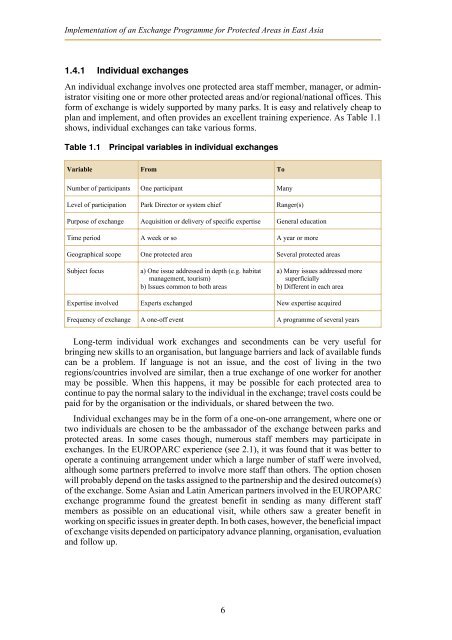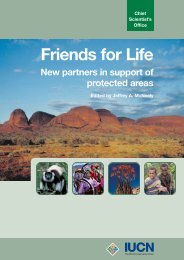Exchange programmes - IUCN
Exchange programmes - IUCN
Exchange programmes - IUCN
Create successful ePaper yourself
Turn your PDF publications into a flip-book with our unique Google optimized e-Paper software.
Implementation of an <strong>Exchange</strong> Programme for Protected Areas in East Asia<br />
1.4.1 Individual exchanges<br />
An individual exchange involves one protected area staff member, manager, or administrator<br />
visiting one or more other protected areas and/or regional/national offices. This<br />
form of exchange is widely supported by many parks. It is easy and relatively cheap to<br />
plan and implement, and often provides an excellent training experience. As Table 1.1<br />
shows, individual exchanges can take various forms.<br />
Table 1.1 Principal variables in individual exchanges<br />
Variable From To<br />
Number of participants One participant Many<br />
Level of participation Park Director or system chief Ranger(s)<br />
Purpose of exchange Acquisition or delivery of specific expertise General education<br />
Time period A week or so A year or more<br />
Geographical scope One protected area Several protected areas<br />
Subject focus a) One issue addressed in depth (e.g. habitat<br />
management, tourism)<br />
b) Issues common to both areas<br />
a) Many issues addressed more<br />
superficially<br />
b) Different in each area<br />
Expertise involved Experts exchanged New expertise acquired<br />
Frequency of exchange A one-off event A programme of several years<br />
Long-term individual work exchanges and secondments can be very useful for<br />
bringing new skills to an organisation, but language barriers and lack of available funds<br />
can be a problem. If language is not an issue, and the cost of living in the two<br />
regions/countries involved are similar, then a true exchange of one worker for another<br />
may be possible. When this happens, it may be possible for each protected area to<br />
continue to pay the normal salary to the individual in the exchange; travel costs could be<br />
paid for by the organisation or the individuals, or shared between the two.<br />
Individual exchanges may be in the form of a one-on-one arrangement, where one or<br />
two individuals are chosen to be the ambassador of the exchange between parks and<br />
protected areas. In some cases though, numerous staff members may participate in<br />
exchanges. In the EUROPARC experience (see 2.1), it was found that it was better to<br />
operate a continuing arrangement under which a large number of staff were involved,<br />
although some partners preferred to involve more staff than others. The option chosen<br />
will probably depend on the tasks assigned to the partnership and the desired outcome(s)<br />
of the exchange. Some Asian and Latin American partners involved in the EUROPARC<br />
exchange programme found the greatest benefit in sending as many different staff<br />
members as possible on an educational visit, while others saw a greater benefit in<br />
working on specific issues in greater depth. In both cases, however, the beneficial impact<br />
of exchange visits depended on participatory advance planning, organisation, evaluation<br />
and follow up.<br />
6






